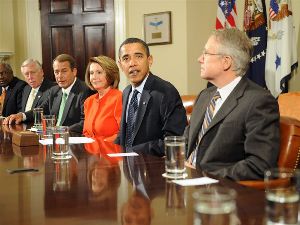By Alec MacGillis, Washington Post
For weeks, the economic stimulus package lay in the hands of President Obama and congressional leaders. But with Obama having signed the $787 billion bill on Tuesday, its fate has been dispersed far and wide — to places such as the state office building in Crownsville, Md., outside Annapolis, where three workers face the challenge of a career. The team oversees the home-weatherization program in Maryland's Department of Housing and Community Development, disbursing $2.6 million a year in federal funds to cities and community groups to insulate the homes of 1,000 low-income residents. The stimulus package provides $65 million over two years, enough to cut deep into the waiting list of 22,000 homes. For the team — an administrator, an auditor and a clerk — it is a once-in-a-lifetime chance to prove their worth, albeit amid higher stakes and more scrutiny than they have ever faced.
"These are guys who have been working this weatherization program for years, who have been stuck back in the corner of the office here . . . and they'd just keep doing their 1,000 homes a year," said Bill Ariano, the agency's deputy director, who added that four others may join the team. "So this is exciting, and it's challenging. It's a long time in coming."
The stimulus package is not only a political crucible for Obama and the congressional Democrats who pushed it through; it is also the ultimate test of government's ability to deliver, from a vast array of federal agencies and departments down to state and local offices across the country.
It will be up to thousands of Cabinet undersecretaries, regional agency directors and local contracting officers to get the stimulus money out fast enough to boost the economy and to meet Obama's broader policy goals. Obama has cast his election as a repudiation of an anti-government philosophy that has been in vogue for the past three decades. The stimulus spending offers the prospect of renewing confidence in the public sector just as many are losing faith in corporate America. If done poorly, though, it could undermine Obama's longer-term vision of reaffirming the positive role of government in the lives of Americans.
"This is an historic opportunity for federal managers to rise to the occasion, to stand up and make sure these dollars are spent well," said Donald F. Kettl, a University of Pennsylvania political scientist. "It's an historic shot, but it's a tough shot. It may be an exaggeration to say they've been set up to fail, but the expectations are very high."
Obama addressed the challenge at a gathering of mayors on Friday. "If a federal agency proposes a project that will waste that money, I will not hesitate to call them out on it and put a stop to it," he said. "What I will need from all of you is unprecedented responsibility and accountability. . . . The American people are watching. They need this plan to work. They expect to see the money that they've earned, that they've worked so hard to earn, spent in its intended purposes without waste, without inefficiency, without fraud."
Administrators seem to be bearing such warnings in mind. On Friday, Interior Secretary Ken Salazar laid out guidelines for the $3 billion his department will receive, including appointing a "stimulus czar." A day earlier, Energy Secretary Steven Chu announced "sweeping" new procedures to get his department's $40 billion spent fast, including adopting a rolling application process for loans and adding staff members.
"The old process required too much paperwork, required prohibitive upfront costs and simply took too long," Chu said. Department staffers, he added, "have a completely new attitude — they feel charged and excited and ready to go."
To help oversee stimulus spending, Chu reached into the private sector, hiring Matt Rogers, a former senior partner at the consulting firm McKinsey & Co. Rogers said in an interview that the moment is a chance for the public sector to prove itself — though all in the service of getting the private sector back on its feet.
"Our obligation is to serve as a demonstration project for the American people that government can work," he said. "It's an opportunity to reignite the economy and get private capital flowing to good projects again, because ultimately that is what we're looking for. Then the private sector can take the reins."
Much of the actual preparation for the money is occurring down the ladder in smaller corners of the government. The U.S. Geological Survey, within Interior, is preparing for $140 million that, among other things, will go toward paying private firms to use new airplane-based laser technology to produce a more accurate topographical map of the country. The information is useful for such things as tracking sea-level rise and flooding.
Matthew Larsen, the agency's associate director for water, said that it was "ironic" that the funding was coming at a time of "economic duress," but also that it is gratifying to play a part. "We are civil servants. We provide science and information to the public and policymakers and are very proud of that role," he said. "To have these extra resources to improve what we do is great."
Processing the rush of money is complicated by requirements unique to the stimulus act. The Department of Housing and Urban Development is getting $1.5 billion for "homelessness prevention," a task in which it has never explicitly engaged.
The National Endowment for the Arts is receiving $50 million in stimulus money but must use a criterion it does not prioritize in giving out its $122 million in annual funding: whether a particular grant is likely to preserve jobs. That means assessing the financial health of arts organizations to determine which might really cut back without a grant.
"We've got a complex job to do, and we're working against the clock," said the endowment's interim chief, Patrice Walker Powell.
Complicating matters further is the leadership vacuum at many agencies, where many top political appointees have yet to be confirmed. Agencies must rely on career officials who are experienced but may not have gotten much training or support over the years.
"It's not easy to go to work and be told that at best you're a kind of sticky cog in the machinery," Kettl said. "You can only expect so much from a system when you do your best to undermine it constantly. And for a long time, that's what we've been facing. The problem is how to rebuild confidence and competence in the federal workforce . . . as one of the biggest challenges in history is being tossed in its lap."
For state and local workers, the challenge may be less related to morale than to the risk of being overwhelmed. The Maryland Energy Administration gets $1 million a year from the federal government to improve energy efficiency. The stimulus act is providing 57 times that amount — on top of the $65 million the state is getting to weatherize individual homes. The state energy director, Malcolm Woolf, said the agency will put part of the money into an interest-free revolving loan program for energy-efficiency projects at state buildings, retrofit big apartment buildings, and expand grants for home-based solar or geothermal systems.
In Virginia, the state gets $4 million a year to weatherize low-income homes, but it is getting $96 million in the stimulus package. With only one full-time and one part-time staffer for the program, the agency is reassigning others to help, encouraging local nonprofit groups it contracts with to broaden the pool of recipients and working with community colleges to train workers for weatherizing jobs.
It is a "huge" undertaking, said the housing division's director, Shea Hollifield, a 26-year agency veteran. But driving her and others is knowing that if it can be pulled off, it will reduce the heating bills of thousands.
"In the short term, it's daunting to spend all this money in as short a time as possible," she said. "But it's awe-inspiring to think about the long-term impact of it."









